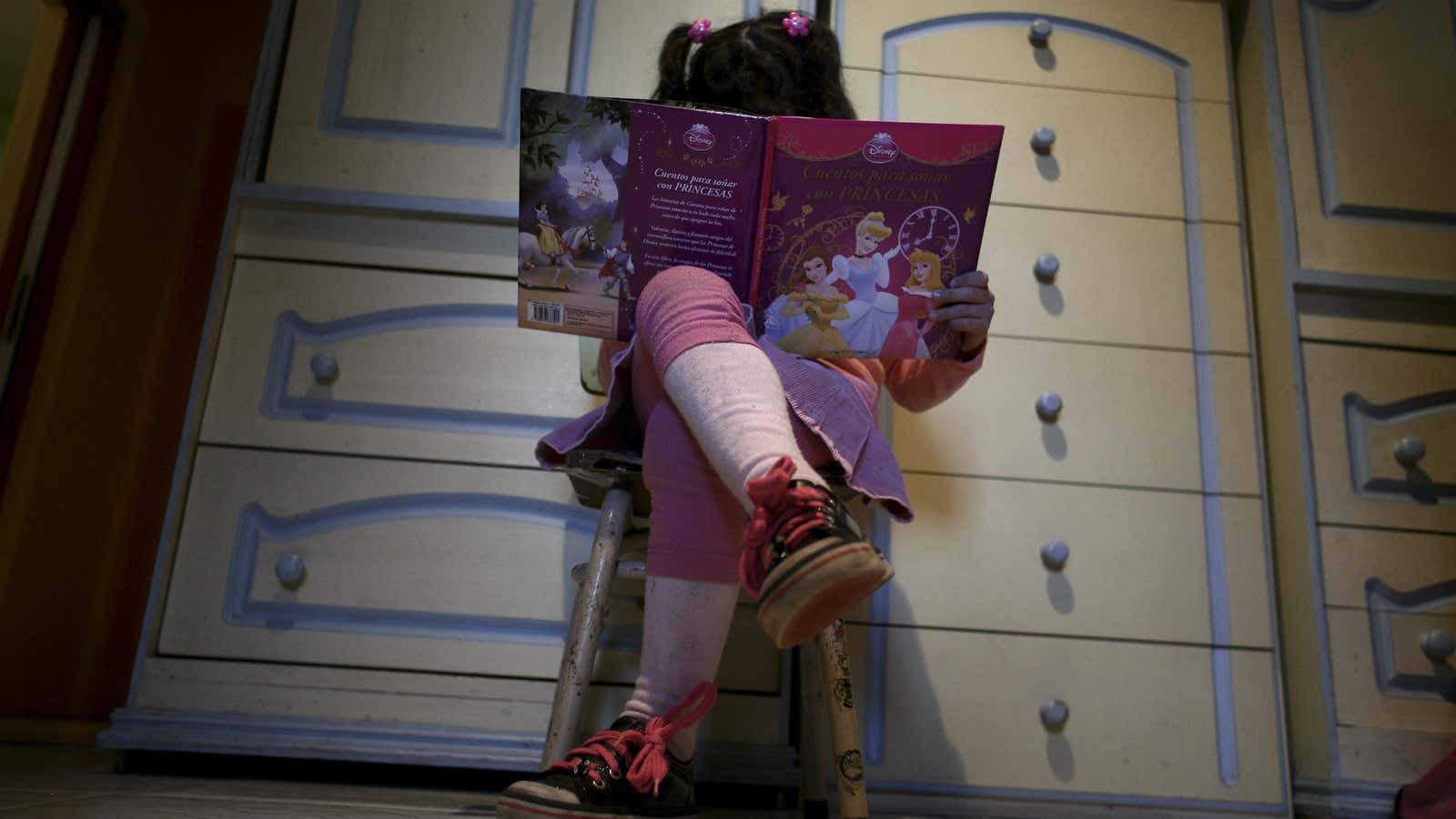I’ve spent a lot of time watching my three- and five-year-old daughters explore, play and read on an iPad. While touch-screen devices are wonderful in many ways, they do a really lousy job in one particular area: deeply engaging kids in narrative. Interactivity is stopping children from falling in love with stories. This, I fear, will have long-term consequences, depriving children of one of the most important benefits of reading for pleasure, the essential inner work of imagination and empathy.
The trouble with tablets
More children now read on electronic devices than read physical books according to a recent survey of nearly 35,000 8- to 16-year-olds conducted by the UK’s National Literacy Trust. But screens don’t seem to be improving their experience of reading. Children who read only on-screen are three times less likely to enjoy reading (12% vs. 51%) and a third less likely to have a favorite book (59% vs. 77%). Other key findings:
- 15.5% of kids who read daily, but only on-screen, are above average readers.
- 26% of those who read daily in print, or both in print and on-screen, read at an above average level.
So why don’t tablets enhance the experience of reading? Most children will not fall in love with reading as quickly as they will get hooked on an interactive game. A touch-screen device makes it all too easy for a child to dismiss reading as boring or “flat” in comparison with the instant gratification of games and apps. There are simply too many distractions just a click away. Children are most likely to engage with stories in the right environment and context, and that means away from a screen.
How interactivity is killing narrative
Interactive stories are designed for young children who may still need guided reading, but that interactivity often creates more of a game experience than a reading experience. Instead of being the focus, the story becomes merely a background.
Best-selling children’s author Julia Donaldson, whose picture books dominate top 10 lists, explains why she vetoed an e-book version of her most famous title, The Gruffalo, in a 2011 article in the Guardian. “The publishers showed me an e-book of Alice in Wonderland,” Donaldson said. “They said, ‘Look, you can press buttons and do this and that,’ and they showed me the page where Alice’s neck gets longer,” said Donaldson. “There’s a button the child can press to make the neck stretch, and I thought, well, if the child’s doing that, they are not going to be listening or reading.”
The typical argument for interactive stories goes like this: Soon enough, children will only read on screens, and where readers are going, publishers must follow. Kate Wilson, the founder of children’s publisher Nosy Crow argues that publishers must create reading experiences for touch-screen devices so that children will continue to read. “We shouldn’t go a little way down the digital path or do it half-heartedly and with reluctance,” she writes. “We should, I think, go to where our readers are going, and make sure that they read along the way.”
Nosy Crow’s apps are favorites of my daughters, but they still fall short when it comes to engaging kids’ imaginations and immersing them in a narrative. Most apps for kids are crammed with interactive inanities, interactivity with no objective apart from getting kids to tap on the screen. This is especially aggravating in storybook apps. The stream of sound and movement signifying nothing does not allow the cognitive and emotional space required to deeply engage with a story in the way that an old-fashioned book does. When we’re engaged in a story, we’re actually feeling the story, imagining how the characters feel and how we would feel in the same situation. That experience is hindered when children are busy trying to figure out what happens next when you tap on the screen.
On books and bonding
Bedtime reading is, sadly, declining and there is some early evidence to suggest that screens are partly to blame. The tablet has become the pacifier of choice in the modern family and both parents and children see using a tablet as a solitary experience rather than a shared activity. A recent poll showed that only 13% of parents read to their kids every night. Interactive stories will never be a substitute for reading a book with a young child. Physical books offer a parent and a child a unique opportunity to bond. During a bedtime story, the only stimuli are the adult’s voice and intonation and the book’s pictures. The best stories require interpretation and stimulate discussion between parent and child.
The reading diet
Reading for pleasure is not instinctual. Unlike the instantly alluring tablet, engaging with stories is an acquired skill that takes time and effort. Parents should encourage a balanced “diet” of online and offline reading—both for older kids reading by themselves and for toddlers who need guided reading—to provide them with the necessary mental space to engage with a story in a deeper way.
The window of opportunity for children to fall in love with reading is shorter than ever. As the author Neil Gaiman recently said: “Fiction can show you a different world. It can take you somewhere you’ve never been. Once you’ve visited other worlds, like those who ate fairy fruit, you can never be entirely content with the world that you grew up in. Discontent is a good thing: discontented people can modify and improve their worlds, leave them better, leave them different.” We don’t want to lose that.
